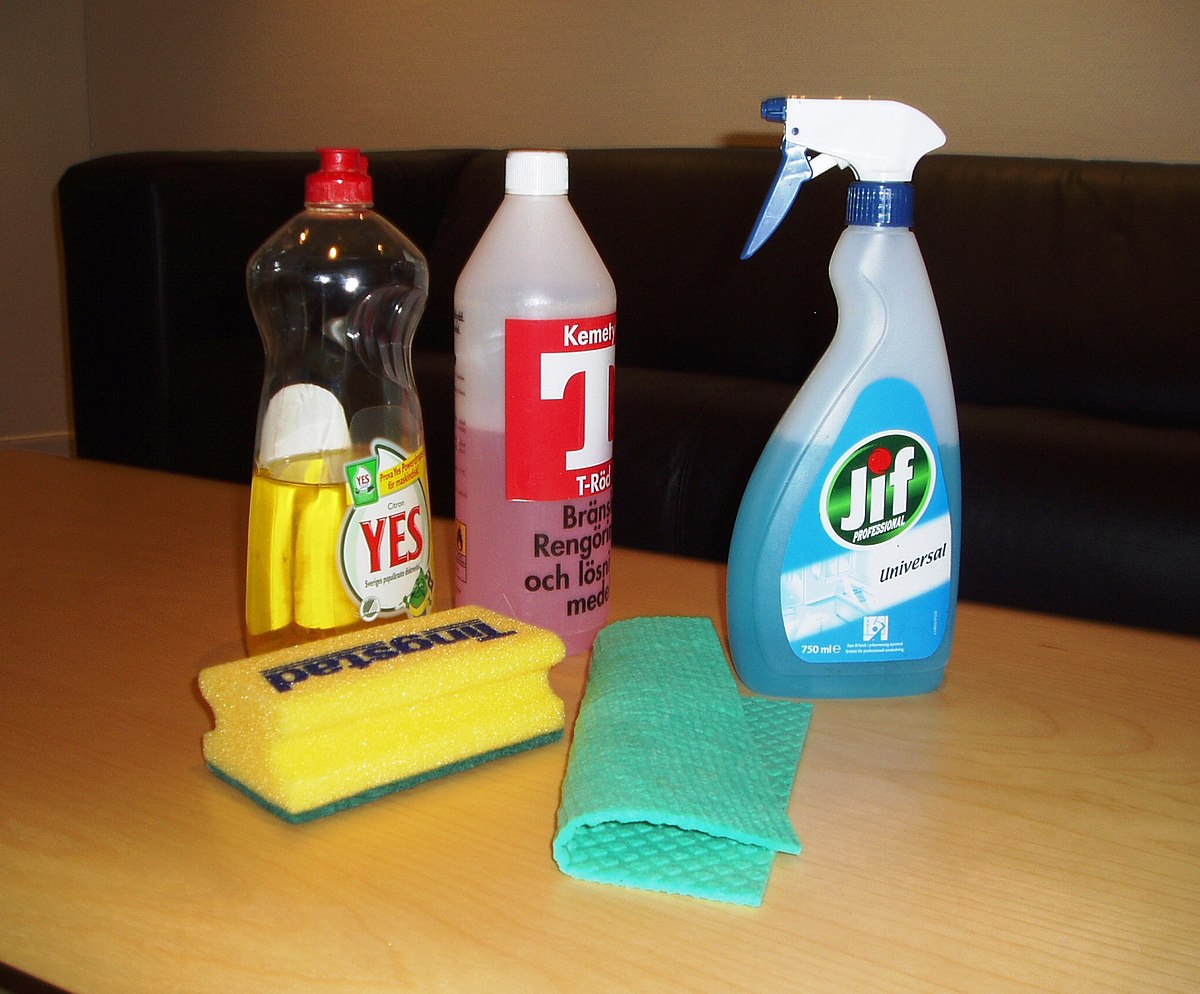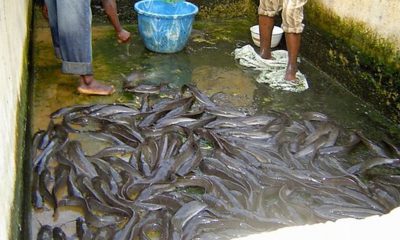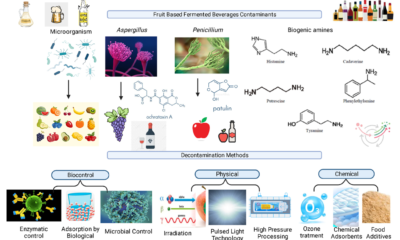Food Security
CHEMICALS IN USE FOR CLEANING PURPOSES IN FOOD PROCESSING INDUSTRY.

■ CLEANING is a function of the Food management system, aimed at reducing the microbial loads on processing equipment and environment.
…..@ WufasAgronet, we are Food Security ( processing ) Advocates
✅Earned FAO Top Fan barge.
✅Member NAAJ, PAAJ, IFAJ & AFAN.
✅Consultancy Services in Human Capital & Value Chain Development.
↔️WufasAgronet was @ various times : ● Factory mgr. NIYAMCO (Ethanol Distillation- molasses ), ● BrewMaster, ●Prod.mgr.-7up bottling co.●Tech.Sales mgr.Cadbury plc. ● GM. Lister Flour mills. ● Plant mgr. Prime Distillery (Gin,whisky etc).● Ceo Wufason Foods (Beverages & Dairy).
CLEANING is very important in effecting a good quality control and to prevent microbes from inflicting damages to products. As a rule of thumb, production activities must be carried out in clean, controlled conditions to prevent contamination of products. Notable of equipment vulnerable to infections are the ones applied for various unit operations eg. Mixing, filiteration, Holding tanks, bottling etc.
CLEANING DETERGENTS ARE :
— CAUSTIC SODA – NaOH , maybe used in solutions up to 15% for removal of beerstone deposits from copper or stainless steel apparatus and pipelines for wort.. it is emphasised that this does not apply to copper beer lines , as copper may easily dissolve in the beer after this alkaline treatment thus causing serious turbidity in the beer.
Causticsoda should never be used for cleaning Aluminium, Enamel, Tin, Isolemail(meura), Hetesite(schlieren) , Metallogen( Hopfel, Hamburg) and other plastic linings.
— SODA ( sodium carbonate ), Na2Co3 .H20, has amilder action than caustic soda and is used in concentrations from 2-6 %. for caning rubber hoses and pipelines of some metals of Enamel or Ebon tanks or if otherwise possible , tanks lined with isolemail. Solutions of sodium carbonate should not be applied however , for cleaning aluminium, unless 0.5% of sodium metasillicate has been added as a corrosion inhibitors.
— SODIUM METASILLICATE, Na2 SIO3.9H2O. Called metasillicate is less alkaline than caustic soda but more so than sodium carbonate. It’s anticorrosive , emulsifing and surface tension- reducing action makes it a valuable component of detergents.
— SODIUM ORTHOPHOSPHATE.(Sodium polyphosphate , “Calgon” Na5 P3 O10 called “polyphosphate” is much less alkaline than metasillicate; but more so than sodium carbonate .its emulsifing and wetting actions and it’s water softening properties makes this substance a valuable component of detergents.
— SODIUM TRIPOLYPHOSPHATE ( Sodium polyphosphate , “Calgon” Na5P3O10 called “polyphosphate” is much less alkaline than orithophosphate, sodium carbonate or metasillicate: it has the property of keeping calcium and magnesiumions in solution ,thus preventing mud ot scale formation on the plant.
— UNIVERSAL DETERGENT ( DV “Universal Reiniginsmiddel” UR ), consisting of 80% sodium metasillicate and 20% sodium TRIPOLYPHOSPHATE. Because it contains TRIPOLYPHOSPHATE the UD may be used in hard industrial water.A 2-2.5% solution of UD has pH of about 11.6 , this is the concentration most frequently used.it is suitable for most cleaning purposes in the brewery for cleaning bottling equipment 0.5 – 1% solution are used.
Universal Detergent has a pH of about 11.6 this is the most used concentration most frequently used. Its suitable for most cleaning purposes in the brewery . For cleaning of bottling equipment 0.5- 1% solutions are used.
— HYPOCHLORITE WITH CAUSTIC SODA.(solutions known as konezol or Antiformin); NaOCL + NaOH, contains- in concentrated solutions — 5% active chlorine and 10% caustic soda. It is a very harsh solution and should only be used in dilution of at least 1: 10 or 1 : 15, thus corresponding with 0.3-0.5% active chlorine . Konezol(diluted) may only be used for cleaning either copper beer lines or for aluminium apparatus. Due to its alkalinity, stainless steel should, under normal circumstances never be cleaned with konezol, unless as done in the dairy industry — the diluted solution (active chlorine content 0.3–0.5% ) is allowed to be in contact with the apparatus for not longer than10minutes at 30°C. Konezol should never be used at higher temperatures.
— CLENSOL is a mixture of organic and inorganic acids to which inhibitors have been added ( in this case corrosive -preventing substances ).for removing scale formation on metals eg incrustation. After using Clensol solution it is necessary to rinse again thoroughly with large volume of water.
— CLENRAD is a mixture of organic acids to which inhibitors have been added ; it’s applications are similar to those of Clensol with the addition that it may be used for cleaning aluminium, tin or zinc plant. One part of Clenrad should be diluted with 3 – 4 parts of hot/cold water. After usage, its always necessary to thoroughly rinse the plant with water.
DISSOLVINE the tetrasodium salt of ethylene diamine – tetra-acetic acid (EDTA) is a complexon that binds metal ions ; not only does it prevent deposits of scale occurring eg in Steam boiler, Hot water Cisterns pasteurisers and washers, but will also dissolve existing deposits.
PHOSPHORIC ACID – H3PO4 may be used in concentrations of 5-10% for cleaning Copper, Bronze, Brass and Stainless steel. Addition of an inhibitor ( 0.1% hexamethylene tetramine ) is necessary . It may also serve as a detergent for tanks lined with some kinds of plastic. Which are not resistant to alkali and also in solutions of 5% to which an inhibitors has been added for de- rusting water pipes, after which the circuit must be thoroughly be rinse with water.
— CHROMIC ACID/ NITRIC ACID/ CLAY; Is a paste prepared by mixing 10kg of potassium dichromate and 50kg of powdery clay ( free from chalk ) or if the latter isn’t available with 50kg of kieselguhr with 15kg or 60% nitric acid.; used in removing beer scale from aluminium tanks. The amount required amount to about 0.3kg/m`.The powdery clay is first mixed with a very little water until a thick paste is obtained, then the dichromate is added and stirred well for 2hrs, finally the nitric acid is added ,( the object of adding nitric acid is to give the clay its proper condition for this purpose . )Enamelled tanks should never be treated with this paste.
……..continues
At WufasAgronet, we are competent and reliable Food Technologists into Human Capital & Value chain Development Consultancy firm. Training the teeming youthful population and graduates of tertiary institutions the fundamental and basic Ethics of Food processing.
Email; wufasagronet@ gmail.com.
Food Security
CHARACTERISTICS OF GOOD DETERGENT

CHARACTERISTICS OF GOOD DETERGENT
www.wufasagronet.com
….. @WufasAgronet, we are Food Security (processing) Advocates.
✅Earned FAO, WFP, WORLD BANK, IFAD, IDA, IMF, UNSDGs, USAID, ROCKEFELLER FOUNDATIONS, BBC NEWS, JAGABAN ARMY, PUNCH NEWSPAPERS, GUARDIAN Newspapers, Today Reporters, Ripples News etc TopFan Barges.
✅Member NAAJ, PAAJ, IFAJ AND AFAN.
✅Consultancy Services in Human Capital and Value Chain Development in Food Processing technology.
DETERGENTS used for washing in industries should have the following characteristics.
-Ability to loosen organic matters eg. Soil etc. (organic dissolving power)
-Good rinsing power.
-Adequate wetting power to allow detergent to penetrate the deposit acting quickly and efficiently.
-Good sequestering power – removal of mineral deposits eg. Calcium, magnesium.
-Emulsifying power – fragmenting oil into tiny particles.
-Adequate germicidal power to sterilized dirty detergent solutions.
-Ability to dissolve alkali solutions precipitate of calcium and magnesium salt.
-It should not be corrosive.
-It should posses good buffering and saponifying powers.
The above characters may not be contained in a single detergent but if blended with others rich in some of the characters, a good result may be achieved.
MAJOR SOURCES OF DETERGENTS.
{Alkalis} – Caustic soda is the basic ingredient of detergent however,
there could be addition of other additives to give a property to the detergent. Other basic ingredients are Soda ash, Sodium silicate and others as seen above.
SEQUESTERING AGENT.
This is the action of polyphosphate in precipitation of calcium and magnesium salts in water creating additional wetting agent and polyphosphate to assist sequestration this would constitute most effective and economical clean-in-place detergent for brewing cleanings.
WETTING AGENT.
Known generally as synthetic detergent, Wetting agents are classified into 3 major types :An-ionic and Cat-ionic wetting agents.
The An-ionc type is commonly used for detergent formulation eg. Sulphated alcohols alkyl or aryl sulphonates. Non-ionic are mostly the polyethylonic oxide. On blending of both an ionic and catonic the result may be excessive foaming. It also processes good wetting, dispersing and rinsing power.
STERILISING AGENT.
Alkalis porcess sterilizing power, which increases with pH and temperature.
At WufasAgronet, we are competent and reliable Food Technologists into Human Capital and Value Chain Development Consultancy in Food Processing. Contact us email :wufasagronet@gmail.comPls go through the earlier sent documents.
Food Security
SEASONINGS. FLAVORS. FOOD INGREDIENTS.

✔Contact us @WufasAgronet for wide range of integrated flavors and seasonings, we are Manufacturers’ Representative.
…. @WufasAgronet we are Food Security (Processing) Advocates.
✅Earned FAO, WFP, WORLD BANK Group, UNSDGS, ROCKEFELLER FOUNDATIONS, BBC NEWS, JAGABAN ARMY, PUNCH NEWSPAPERS, GUARDIAN Newspapers, Today Reporters, Ripples News, etc TopFan Barges.
✅Member NAAJ, PAAJ, IFAJ & AFAN.
✅CONSULTANCY SERVICES IN HUMAN CAPITAL AND VALUE CHAIN DEVELOPMENT IN FOOD PROCESSING.
✔FLAVORS
BAKERY & PASTRY FLAVORS
*Vanilla flavor
*Condensed milk flavor
*Butter scotch flavor
*Enzyme chocolate flavor
*Enzyme butter flour
*Milk flavor
*Coconut flavor
✔ CONFECTIONERY & CANDY FLAVORS
*Strawberry flavor
*Chocolate flavor
*Orange flavor
*Butter vanilla flavor
*Banana flavor
*Mango flavor
*Lemon flavor
*Milk flavor
*Vanilla flavor
*Apple flavor
*Mixed berry flavor
*Coconut flavor
*Caramel flavor
*Honeydew flavor
*Condensed milk flavor
*Peanut flavor
*Cheese flavor
✔BEVERAGE FLAVORS
*Apple flavor
*Coconut flavor
*Caramel flavor
*Mango flavor
*Lemon flavor
*Banana flavor
*Pineapple Flavor
*Orange flavor *Strawberry flavor
*Natural Ginger flavor
*Malta flavor
*Grape flavor
*Raspberry flavor
✔ENCAPSULATED FLAVORS
*Strawberry flavor
*Raspberry flavor
*Mixed Berry flavor
*Orange flavor
*Apple flavor
*Banana flavor
✔BEVERAGES (CONCENTRATES, COMPOUNDS, BASES AND EMULSIONS) :
*Pineapple
*Lemon
*Ginger
*Cola
*Black currant
*Orange
*Strawberry
*Chapman
*Apple
*Banana
*Mixed fruit
*Cocopina
✔SAVOURY FLAVORS
*Beef flavor
*Chicken flavor
*Tomato flavor
*Cheese flavor
*Seafood flavor
*BBQ flavor
*Roasted flavor
*Smoked fish flavor
*Suya flavor
*Peanut flavor
*Roasted Chicken flavor
*Sardine flavor
*Smoke flavor
✔MILK POWDER :
*Fat filled milk powder
*Skimmed milk powder
*Full cream powder
*Flavored milk powder
*Butter milk powder
✔ICE-CREAM, YOGHURT & DAIRY FLAVORS :
*Yogurt flavor
*Vanilla flavor
*Strawberry flavor
*Banana flavor
*Mixed Berry flavor
*Chocolate flavor
*Cherry flavor
*Mango flavor
✔SEASONINGS:
FOOD SEASONINGS
*Beef seasoning
*Chicken seasoning
*Tomato seasoning
*Cheese seasoning
*BBQ Seasoning
*Seafood seasoning
*Noddles seasoning
*Pasta seasoning
*Jollof seasoning
✔SPICES :
*Cinnamon powder
*Onion powder
*Ginger powder
*Garlic powder
*Paprika powder
*Nutmeg powder
✔FOOD INGREDIENTS :
*Fat Replacer (Handisol – 25)
*Sweetener
✅OTHERS :
*Real meat reaction pastes
*Vegemeat for sausage roll
*Spice flavor oil
*Liquid and oil soluble flavor
*Soup and gravy mixes
*Ice cream premix
*BBQ sauce
*Tomato /Pizza sauce etc.
At WufasAgronet , we are competent and reliable Food Technologists into Human Capital and Value Chain Development Consultancy in Food Processing technology training the teeming youthful population including teirary institutions graduates in Global Competitiveness and International Best practices in Food Processing technology.
Contact email wufasagronet@gmail.com
Food Security
SECURITY PATHWAYS IN RELATION TO SUSTAINABLE FOOD SECURITY OF A NATION.

Good governance is predicated on ensuring the actualisation of the various security architecture of a Nation. The political barometer is also monitored through the efficiency of the security pathways which are :
INTERNAL SECURITY, INFORMATION/COMMUNICATION. , FOOD SECURITY, HEALTH ,EDUCATION, ELECTRICITY, TRANSPORTATION AND INDUSTRIAL GROWTH.
.
All the above are the essential security systems that can produce and provide QUALITY POPULATION through good and quality SUPERVISION
✅NATIONAL Security of life and properties is the (numero uno) number one responsibility of the Head of government be it President, Head of state and others. The mandate to secure life and property is paramount , they control and command the apparatus of security such as adequate Policing, effective Armed forces- Army for protection against external or internal aggression. Customs / Immigration for vigilant boarders patrol to prevent smuggling and immigration control amongst many others . Equipping them with weapons, Aircrafts, Vehicles, Boats etc.
For effective surveillance. In tackling the menace of bandits and kidnappers who have taken over the forest prohibiting farming activities . Armed Forest Guards / Rangers should be introduced.
INFORMATION/COMMUNICATION.
The entire world is in information age.
The constitution clearly stipulate that every person shall be entitled to freedom of expression, freedom to hold opinions and to receive as well as to impact ideas and information.
However, it is the opinion of this writer that freedom be guided with secured intent to prevent abuse that may result in conflicts and war through hateful and unguided utterances.
The most acceptable form of communication is such that promote humane, responsible and patriotic reportage upholding the concept of discipline and promoting values nationally and internationally.
A lot of opportunity mostly untapped abound for investment in Information and communication like Print, Electronic and ICT media.
For industrial growth, information through advertisement, publication and social media is vital for public awareness.
FOOD SECURITY
Whether one eat to live or live to eat is a matter of semantics the bottom – line is Food is the main sustainace of bodies and souls. The importance of food cannot be over emphasised . knowing this fact of life has made the developed world to appropriately plan for provision of quality food for their citizens. Provision of food is prioritize in their national agenda. It is on this note that the United Nation’s clarion call to others in the world to emulate the culture of Sustainable Food Security ensuring the Tripple A(s). of AVAILABILITY, ACCEPTABLITY and AFFORDABILITY. ( UN 2030 food security agenda) of good quality food for the underdeveloped countries who are import dependent on basic food items such as Rice, Sugar, Dairy , Beverages etc .
Presently, Nigeria is revolutionising agrioprenuerial activities, it’s hoped that the present policies on agriculture will not be Summersaulted. The Maputo declaration on allocation of minimum 10% of the country’s annual budget must go to agriculture. Food must be made a constitutional right for all. The authority must take time to support Micro and Small scale Agroprenuerails activities to adapt to climate change. Agroprenuerail activities is the surest way to lift hundreds of millions out of hunger, poverty, conflict and deaspiration.
HEALTH CARE
Health is wealth – Primary Health care delivery must be taken to the grassroot levels, while Rural Health care moblisation be made available and effective all must be well equipped with vaccines, drugs, consumables and other biologicals.
— Ensure maintenance of standard by private sector through effective monitoring.
— Tapping into Herbs Processing , local medical herbs be Researched into by National Institute of Pharmaceutical RnD. In Collaboration with Fed Mins. of Science and Technology.
— Integration of alternative medicine into health care.
— Health insurance scheme must be intensified on .
— Stemming of illegal importation of smuggled fake drugs and illegal drug manufacturing in the country.
EDUCATION
A Society, Community and Nation is as good as the percentage of her literary population. The various levels of education are Primary , Secondary and teriary education 6-3-3-4 .Education must attract appropriate budget at all time. Education is being administered by Public and Private participation at all levels. The special education must receive attention by provision of special equipment such as braille machine, audiometer etc.
ELECTRICITY
To the chagrin of the unsuspecting consumers and Contrary to claim of the generation companies that generation capacity has improved to 7000 MW , the actual has been fluctuating between 2500 -3500 MW.(April 2019)
The idea of mono grid must be jettison while the legislation be relaxed to accommodate Private participations in generation. While effort must be intensified on the Green Bond of #10.97bn raise in December 2018. for financing of SOLAR energy.
Industrial development is unachievable without steady supply of electricity. A green belt of
Industrial Parks on Green energy is recommended in all the States of federation.this will sustain industrial activities that will promote growth.
TRANSPORTATION
This sector is an indispensable catalyst for stimulating economic, social, political and strategic/defence development of a Nation. All the National Development plans must accord the transport sector very high priority. In the formulation of National Transport policy, there must be defined objectives such as economic efficiency and coordinated development plan.
All forms of transportation system are embraced in Nigeria. Motor ,Railway transportation, inland waterways, aviation terminal and handling facilities seaports, airports and riverports including other ancillary facilities.
The administration of Transportation is vested in both Fed. Ministry of Works and Housing (Fed. Highways – Interstate roads Construction and maintenance) and State Ministry of Works/Transport (interstate roads while LG is responsible for Urban and Rural roads Construction and maintenance.
Aviation Ministry for Civil Aviation, Airports Development Management and Metrological services.
Internationally, the railway system is more affordable and relatively saver the frequency in Nigeria must be upgraded not scanty show up as is now the case.
INDUSTRIAL GROWTH
The economic growth rate ( 2019) is 2.1% ,this development is not unconnected with the dismal performances of the various indices above. eg the manufacturing growth rate is presently less than 7% although the Fedreral government set a 10.6% goal in 2017.which was to be driven by SME. Productivity is the only stimulant for Industrial growth. Farming output is barely about 22% mostly subsistence. .about 55% of work force is absorbed by agriculture. The major farming communities in North East, Middle belt downwards to the southern section are being sacked either Boko Haram terrorist or Pasteuralist /Farmers conflicts and banditry.
The various activities as enumerated in this writeup are all depended on Food security system. FOOD SECURITY MUST BE IN THE FRONT BURNER TO ACHIEVE SUCCESS. IN OTHER SEGMENTS.
CONCLUSION
— FOOD Security issues must be in the front burner of government’s agenda. Since it encompasses all other activities.
— The effectiveness of other parasatal must be ensured through adequate supervision.
— TO PREVENT IMMINENT DANGER OF FAMINE. Forest Guards (armed) must be appropriately deployed to secure the large expanse of the forest for Farming activities.
— Indigenous Reserch and Development on local Technology be improved on.
— Electricity generation from Green Energy source should be encouraged in the Industrial parks.
— Food Security system must be made a CONSTITUTIONAL RIGHT for all the citizenry.
At WUFAS AGR0Net, we are Competent and Reliable Food Processing Technologists ,into Human Capital Development Consultancy. Centering on ETHICS of Food Processing Technology. Training on industrial food processing (General Manufacturing Principles ) to the teeming youthful population, startups and other Food handlers. We are seeking Collaboration and Strategic partnership with corporate bodies, NGOs and others
Interested in Food Security.
Contact: 08157784430, 08034064270.
Emails wufasagronet @gmail.com
-

 Environmental3 years ago
Environmental3 years agoOPINION: AN ACCESSMENT OF NIGERIA’S PERFORMANCE IN THE OPTICS OF THE UN 17 SUSTAINABLE DEVELOPMENT GOALS AGENDA 2030. ( Periodic quaterly review & update — ( September ’22)
-

 Food Security3 years ago
Food Security3 years agoREALITIES OF LARGE SCALE INTEGRATED AGROPRENUERAIL FARMING AND FOOD PROCESSING BUSINESS IN NIGERIA. (Update)
-

 Food Security4 years ago
Food Security4 years agoEXCITING FACTS ABOUT RANCHING
-

 Food Security3 years ago
Food Security3 years agoTOP SEVEN AGRICULTURAL COMMODITIES WITH HUGE UNTAPPED POTENTIALs – update
-

 Food Security4 years ago
Food Security4 years agoMITIGATING THE MENACE OF CLIMATE CHANGE THROUGH GREENBOND ISSUANCE.
-

 Food Security4 years ago
Food Security4 years agoFISH PROCESSING TECHNOLOGY
-

 Food Security3 years ago
Food Security3 years agoMICROBIOLOGICAL AND CHEMICAL EVALUATION OF LOCALLY FERMENTED BEVERAGES — PITO & BURUKUTU
-

 Food Security4 years ago
Food Security4 years agoTHE ROLE OF E -COMMERCE IN SYNERGISING AGRICULTURAL VALUE CHAIN DEVELOPMENT IN AFCTA IS SINE QUA-NON.


